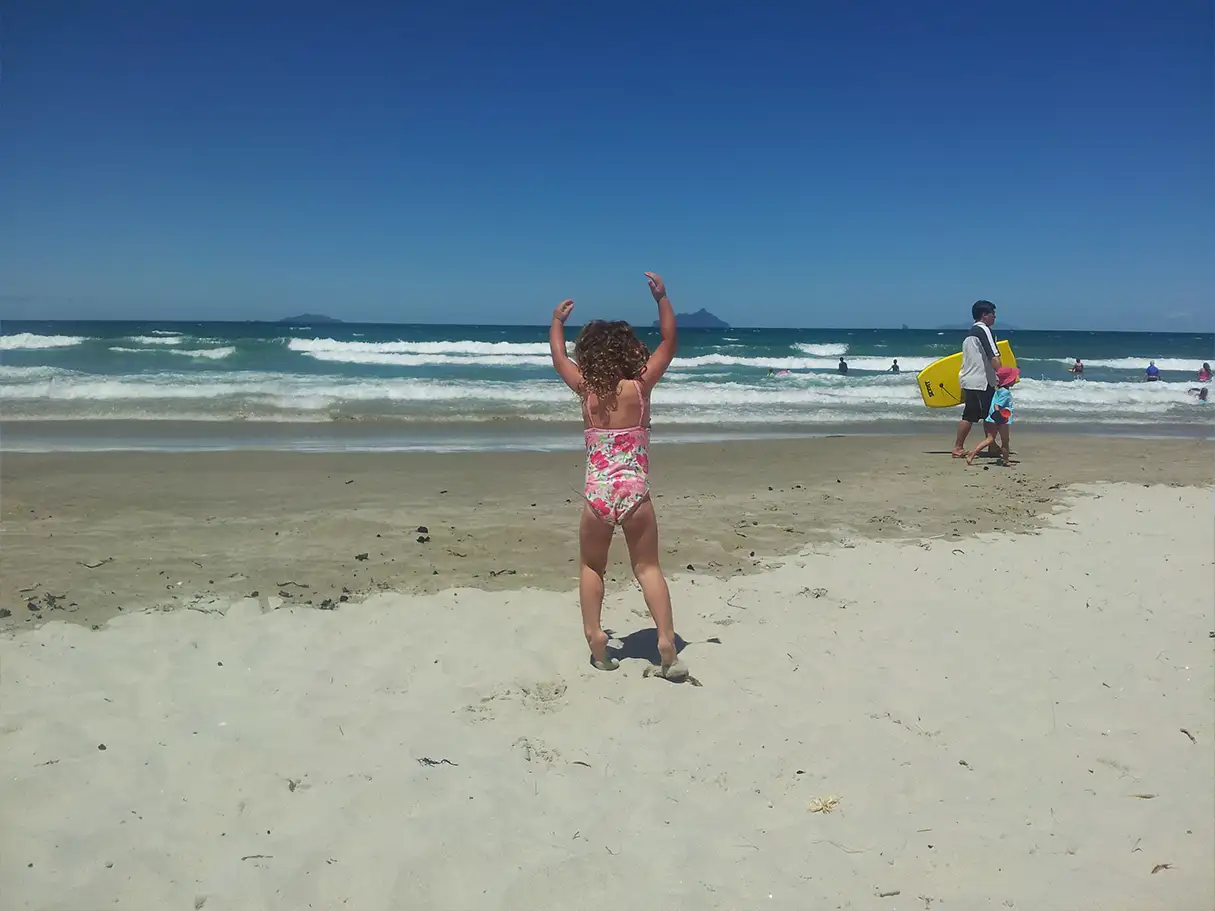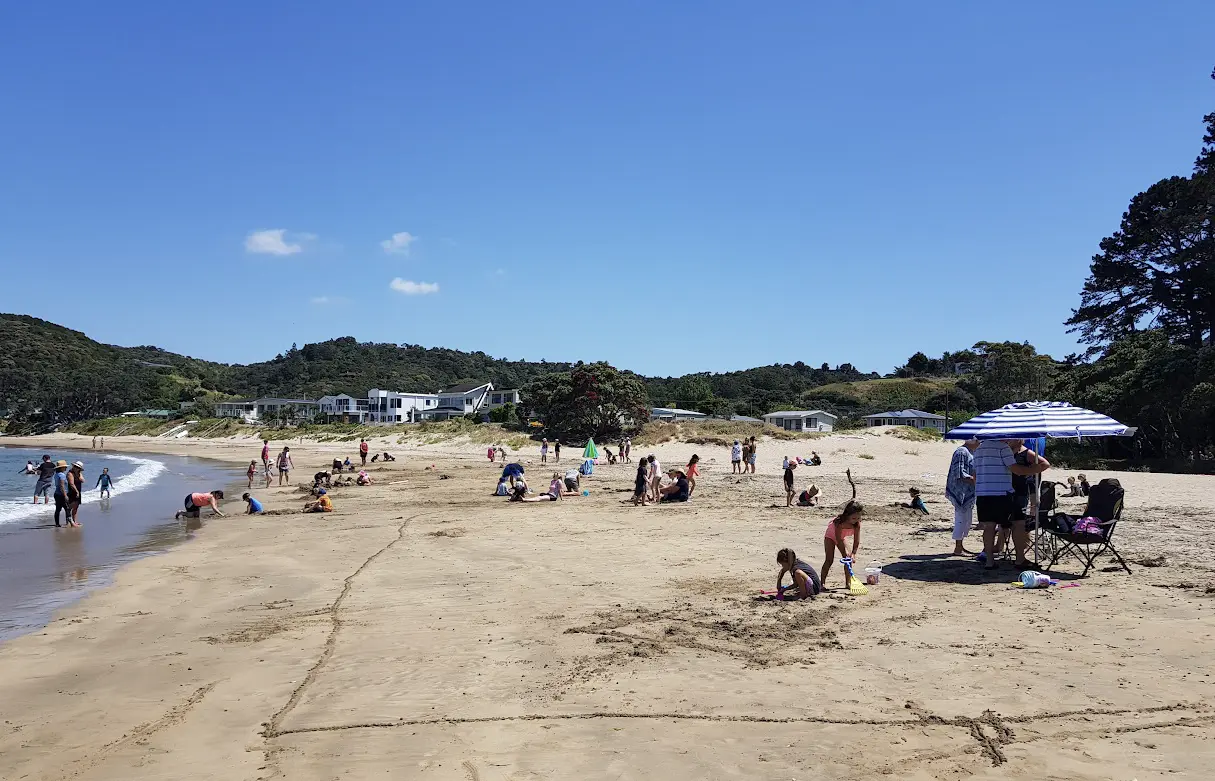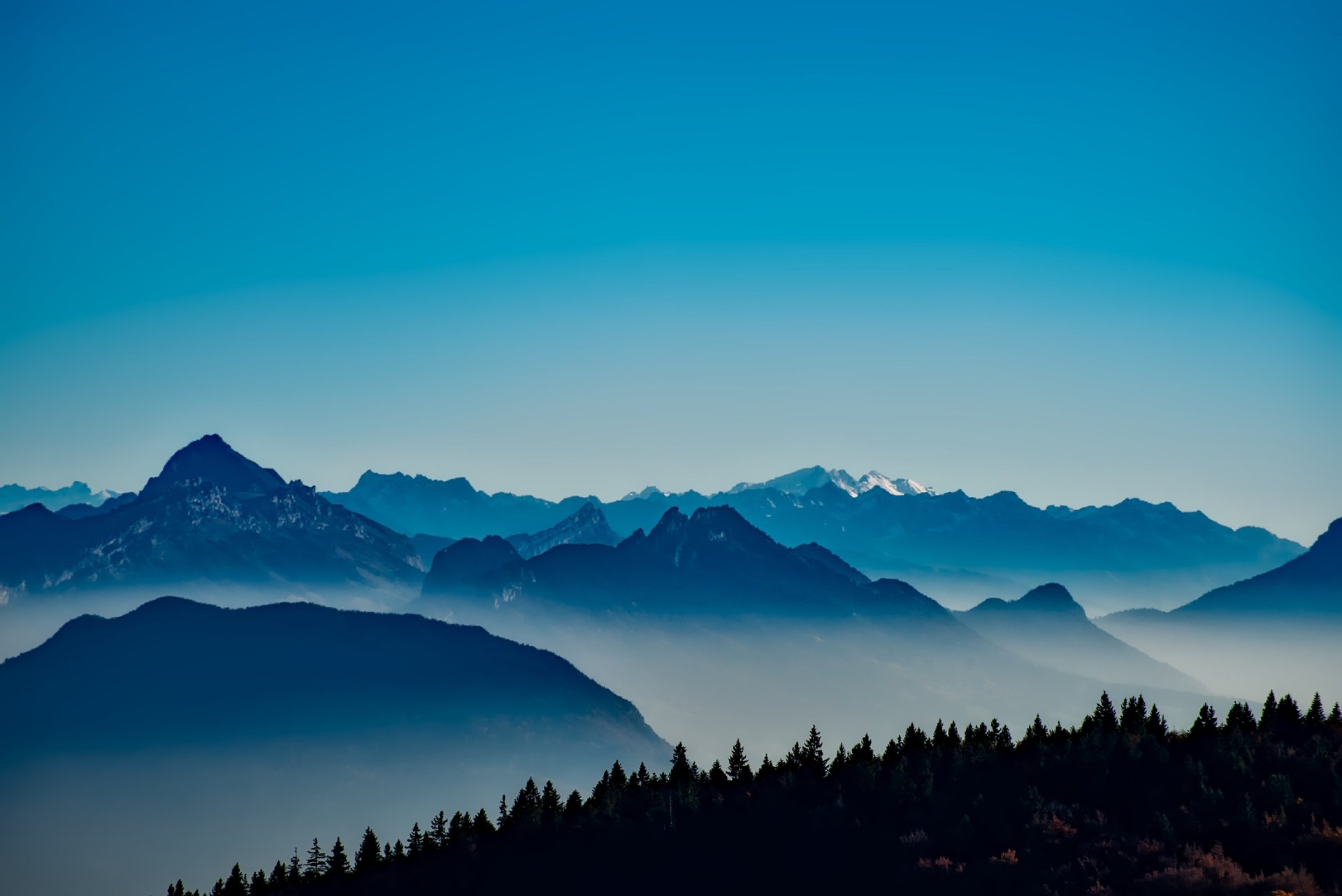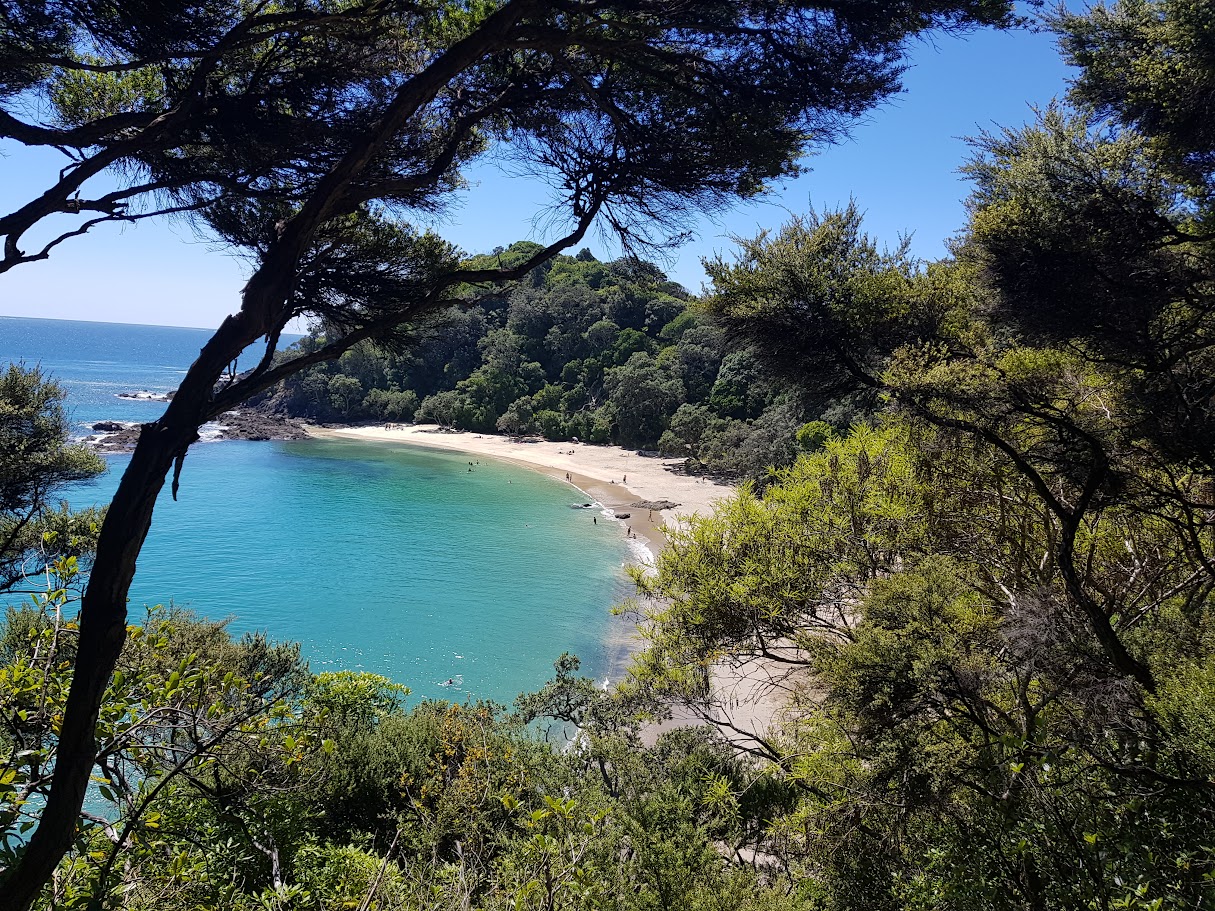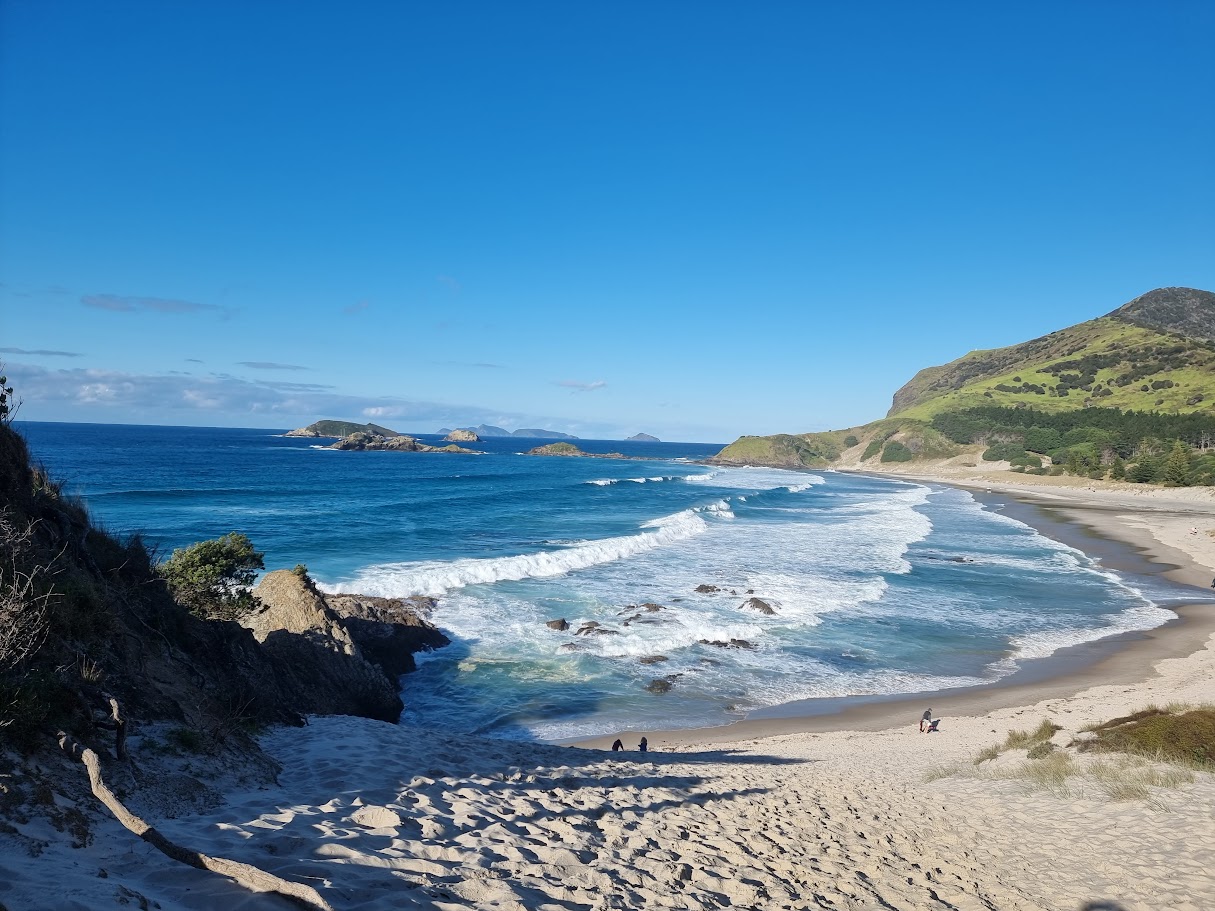Langs Beach is one of Northland’s quieter coastal gems, a beautiful crescent-shaped beach on Bream Bay where you can still find genuine peace and space. Located approximately 45km (28 miles) south of Whangarei, 11km (7 miles) south of Waipu township, and about 10km (6 miles) north of Mangawhai Heads, this white sand beach offers a more relaxed alternative to busier Northland beaches. With Pohutukawa-lined shores, turquoise waters, excellent swimming conditions, and access to the spectacular Waipu Coastal Walkway, Langs Beach delivers a classic Kiwi beach experience without the crowds.
Langs Beach and Bream Bay
Langs Beach is part of Bream Bay, that sweeping 22km (14-mile) expanse of coastline stretching from Marsden Point in the north to Bream Tail near Langs Beach and Mangawhai Heads in the south. Captain James Cook named Bream Bay in the 1770s after noticing the bay’s waters were full of what he thought were bream, though he was likely seeing snapper. Regardless of the fish identification error, the name stuck.
The beach itself is a beautiful crescent shape, hugging the teal waters of Bream Bay. It’s approximately 800 metres (half a mile) long, facing eastward, which means you get stunning sunrise views across the Pacific Ocean and out to the Hen and Chicken Islands, approximately 21km (13 miles) offshore. On clear days, you can also spot Sail Rock from the beach.
The locality was named after early settlers Duncan McKenzie and William Lang, who bought land blocks around 1856. McKenzie Cove (the small bay at the northern end of Langs Beach) commemorates Duncan McKenzie. Lang’s family subsequently bought out McKenzie’s holdings, and their farm was gradually sold in pieces from 1927 to 1990. In 2019, Langs Beach was described as Northland’s most expensive suburb, reflecting its transformation from farmland to a sought-after coastal community.
Today, Langs Beach retains a quiet, relaxed character. Unlike neighbouring Waipu Cove, which has lifeguards, cafes, and shops, Langs Beach has kept its low-key feel. There are no commercial developments, shops, or restaurants at the beach itself; this is intentional and part of what makes the area special to residents and visitors who value the unspoiled coastal setting.
Getting There and Parking
Access to Langs Beach is straightforward. From Whangarei city centre, head south on State Highway 1 for approximately 35km (22 miles), then take Cove Road towards Waipu Cove and Langs Beach. The drive takes roughly 35-40 minutes from Whangarei. From Auckland, you’re looking at about 1 hour and 45 minutes north via SH1.
If you’re coming from Waipu township, head east on Cove Road for about 10 minutes (8km or 5 miles). The road to Langs Beach is well-signposted. As you approach the beach, Cove Road runs parallel to the shoreline.
Parking: Parking at Langs Beach is along Cove Road, the main road that runs alongside the beach. There’s street parking on both sides of the road for much of the beach’s length. Parking is free, though spaces can fill up during peak summer periods, particularly weekends and public holidays in December and January.
The best parking is typically found near the southern end of the beach where there’s a small beachfront reserve with toilet and changeroom facilities. This is where most day visitors congregate. Additional parking is available along the road towards the northern end.
During busy summer days, arrive early to secure a good spot, particularly if you want to be close to the facilities. Alternatively, park further from the main area and enjoy a short walk along the beach; one of Langs Beach’s charms is that you can walk a bit and find quieter sections.
For boat launching, there’s access at the southern end of the beach. If you have a tractor or 4WD vehicle, you can launch directly from the beach. This end is also popular with families because the water is more sheltered and waves are limited.
The Beach Itself: What to Expect
Langs Beach has fine, white sand that forms a gently curving crescent along Bream Bay. The sand is soft and comfortable, perfect for laying out towels, building sandcastles, or walking barefoot. At low tide, the beach widens significantly and the sand becomes firmer near the water’s edge, making it excellent for long walks or beach games.
The defining feature of Langs Beach is the magnificent pohutukawa trees that line the shore. These native New Zealand Christmas trees provide welcome natural shade during summer months, saving you from having to bring beach umbrellas or pop-up tents. The gnarled trunks are perfect for kids to climb on, creating a natural playground. During December and January, the pohutukawa bloom with brilliant red flowers, adding to the beach’s beauty.
The beach slopes gradually into clear, turquoise waters. Water clarity is generally excellent, and you can often see your feet in knee-deep water. The gentle waves make Langs Beach particularly suitable for families with children, bodyboarding, and swimmers of all abilities. The southern end of the beach is especially sheltered and calm, making it ideal for young children.
Behind the beach, you’ll find a mix of holiday homes (many available as holiday rentals) and some permanent residences. The hillside above the beach, known as Langs Beach Estate, is a gated community on nearly 200 hectares with sweeping views. The Old Langs area near the beach has a collection of traditional Kiwi baches with character and charm.
At the northern end of Langs Beach, rocky headlands define the boundary. At low tide, you can walk around these rocks to reach Ding Bay, a small, sheltered cove that feels like a secret spot. This walk requires checking tide times, as it’s only accessible when the water is low.
Swimming and Water Safety
Langs Beach is popular for swimming and offers generally excellent conditions with gentle waves and clear waters. However, it’s important to understand the safety considerations. The beach is not patrolled by lifeguards at any time of year. Swimming is at your own risk, so assess conditions carefully before entering the water.
The Northland Regional Council monitors water quality at Langs Beach regularly during summer months. Water quality is generally good and suitable for swimming. Monitoring results are updated through the LAWA (Land, Air, Water Aotearoa) system, with predictions checked every 15 minutes during the swimming season.
Water Quality: The beach consistently passes water quality tests for swimming safety. However, after heavy or prolonged rain, avoid swimming for two to three days. Rain flushes contaminants from land into waterways, which can temporarily affect water quality even at beaches that usually have excellent conditions. Always check that the water looks clean and clear before swimming.
You can check current water quality status online through the LAWA website before visiting, particularly if there’s been recent rain.
Swimming Conditions: The beach faces east into Bream Bay, which means it’s exposed to ocean swells, though generally less so than more northerly Bream Bay beaches. The southern end of the beach is more sheltered and has calmer conditions, making it the preferred spot for families with young children. As you move towards the middle and northern end of the beach, wave action increases.
Swimming Safety Tips:
- Never swim alone, especially at an unpatrolled beach
- Be aware of rips and currents; if caught in a rip, don’t panic, raise your hand for help and float or swim parallel to the beach
- Watch children at all times, even in shallow water
- The southern end offers the calmest, most sheltered swimming
- Don’t swim under the influence of alcohol
- Be cautious in rough conditions; waves can be unpredictable on this exposed coast
- Assess conditions carefully before entering the water
- If in doubt, stay out
If you’re with children or less confident swimmers and want lifeguard patrols, Waipu Cove (about 5km or 3 miles north) has lifeguards on duty every weekend between Labour Weekend and Easter, and daily during the busy holiday period.
Surfing and Water Sports
Langs Beach works for surfing when swells come through, though it’s generally not as consistent as Waipu Cove. The beach break creates waves suitable for bodyboarding and boogie boarding, which are particularly popular activities here. Kids and families often enjoy the gentle to moderate waves with a boogie board.
The beach is good for:
- Bodyboarding and boogie boarding in the gentle to moderate waves
- Kayaking, exploring the bay and paddling to nearby coves
- Paddleboarding, especially on calmer days
- Beach fishing; the beach and rocky areas offer fishing spots
- Swimming and snorkelling, particularly around the rocky areas at either end of the beach
The Hen and Chicken Islands, visible offshore (21km or 13 miles away), are a protected sanctuary. While the islands themselves are off-limits, the surrounding waters are excellent for diving, fishing, and snorkelling. Various marine life can be found including blue maomao, snapper, trevally, crayfish, and scallops. Several local charter operators offer diving and fishing trips to the islands from nearby Waipu Cove or Tutukaka.
For launching boats, the southern end of Langs Beach allows launching with a tractor or 4WD vehicle. Many locals bring their boats down during summer for fishing or water sports. Be mindful of other beach users and observe proper boat launching etiquette.
Facilities and Amenities
Langs Beach maintains its low-key character by having limited but adequate facilities. This is part of its charm; if you want extensive amenities, Waipu Cove or Ruakaka might be better choices.
At the Beach:
- Public toilets located at the southern end of the beach
- Changerooms next to the toilets
- Some picnic tables and grassy areas
- Pohutukawa trees providing extensive natural shade
- Street parking along Cove Road
- No rubbish bins; pack out what you pack in
- No playgrounds or structured facilities
During Summer:
- Zippy’s Cafe, a yellow coffee and ice cream truck, visits daily during summer months, typically arriving in the morning and staying through the afternoon. They serve excellent coffee and make real-fruit ice creams, perfect for impromptu seaside picnics. This is the only food service at the beach.
What Langs Beach Doesn’t Have: There are no shops, cafes, restaurants, or commercial services at Langs Beach itself. This is by design; local planning rules prevent commercial development to preserve the beach’s residential and natural character. While this might seem inconvenient, many visitors appreciate the unspoiled feel it creates.
Nearby Amenities: The nearest services are in Waipu township, about a 10-minute drive (8km or 5 miles) from the beach:
Waipu has:
- Four Square supermarket for groceries and supplies
- Waipu Bakery for fresh bread and baked goods
- Butcher
- Pharmacy
- Medical centre
- Petrol station
- Post shop
- Several cafes and restaurants
- Hardware store
Waipu Cove (5km or 3 miles north) has:
- The Cove Cafe, Restaurant & Bar overlooking the beach
- Waipu Cove General Store for basics, ice creams, and fish and chips
For more extensive shopping and dining, Whangarei is 35-40 minutes north, and Mangawhai is 20 minutes south.
Dining Options
Since there are no permanent food services at Langs Beach, planning ahead is essential.
At the Beach:
- Zippy’s Cafe truck (summer only) for coffee and real-fruit ice creams
Within 10-15 Minutes: The Cove Cafe, Restaurant & Bar at Waipu Cove (about 5 minutes away) offers a range of food and beverages in a beachside setting with views across to Whangarei Heads. Open 9am to late daily, with extended hours in summer. They serve breakfast, lunch, and dinner, using produce grown on the owners’ farm in Maungakaramea. This spot won the people’s choice award for most outstanding restaurant, cafe & bar in the 2020 Northland Hospitality Awards.
Waipu Cove General Store (5 minutes) sells fish and chips, pies, ice creams, and basic groceries.
In Waipu Township (10 minutes): McLeod’s Pizza Barn is a well-loved institution for its generous pizzas and good vibes. The owners have added McLeod’s Brewery onsite, serving craft beers that are now pulled at pubs around New Zealand.
Waipu Central (currently operating from a temporary location) serves AllPress coffee, cabinet food, fresh salads, and in-house baking.
Other Waipu cafes and takeaways offer various options for casual dining.
In Mangawhai (20 minutes south): Bennetts of Mangawhai offers long lunches in a Tuscan-style courtyard setting, plus a boutique chocolate shop.
Various other cafes and restaurants in the growing Mangawhai dining scene.
Practical Advice: For a day at Langs Beach, pack a picnic, bring a chiller with drinks and snacks, and enjoy eating under the pohutukawa trees. This is how most locals and regular visitors do it, and it’s part of the Langs Beach experience.
Accommodation
Langs Beach has no hotels, motels, or commercial campgrounds. Accommodation consists entirely of holiday homes and baches available for private rental. This contributes to the quiet, residential feel of the area.
Holiday Rentals: Numerous holiday homes and baches are available for rent at Langs Beach through various booking platforms including Bachcare, Bookabach, Airbnb, and Bach Rentals. Properties range from classic Kiwi baches with character to modern holiday homes with stunning views.
Expect a mix of:
- Beachfront properties with direct beach access
- Hillside homes with panoramic ocean views
- Traditional baches with a relaxed, casual feel
- Modern architect-designed homes with high-end facilities
Many properties sleep 6-10 people and are ideal for families or groups. During peak summer (particularly Christmas through January), book well in advance as the beach is popular and options fill up quickly.
Nearby Accommodation Options: Camp Waipu Cove (5 minutes away) is a holiday park right on the beachfront/estuary with:
- Tent sites
- Powered sites for campervans
- Cabins and tourist flats
- Full facilities including kitchens, laundries, toilets, showers
- Tennis court, playground, games room
- BBQ areas and boat ramp
- Bird sanctuary with 45 recorded species
- Free wifi and EV charging
Waipu township (10 minutes) has additional accommodation including B&Bs and holiday rentals.
Mangawhai (20 minutes south) offers motels, holiday homes, and the Mangawhai Heads Holiday Park.
Whangarei (35 minutes north) has the full range of hotels, motels, and other accommodation for those wanting to use Langs Beach as a day trip destination.
Activities and Attractions
Beyond swimming and beach time, Langs Beach and the surrounding area offer excellent activities:
Waipu Coastal Walkway: The most popular activity from Langs Beach is the stunning Waipu Coastal Walkway, one of Northland’s best coastal walks. This 3km (1.9-mile) track runs between Waipu Cove and Langs Beach, taking in spectacular panoramic views across to the Hen and Chicken Islands.
The walkway follows a craggy coastal bluff with dramatic cliffs, unique ‘pancake’ limestone rock formations, hidden coves, and native bush. It’s rated as moderately challenging due to some rock scrambling, tree roots, ladders, and exposed sections near steep drop-offs. The track can be muddy and slippery after rain. Wear sturdy shoes, take care with children, and allow 1.5 to 2 hours for the walk.
Access points are at both Waipu Cove (at Waterman Drive) and at Langs Beach (Ding Bay end). You can walk one way and arrange pickup, or do it as a there-and-back walk. The Waterman Drive to Waipu Cove section is suitable for most fitness levels, while the Waterman Drive to Ding Bay/Langs Beach section requires more agility.
The walkway crosses private land in places, so stay on the track and follow the orange markers. The entry points at both Waipu Cove and Ding Bay may require wading through water, so check tide times before starting.
Ding Bay: This small, sheltered bay at the northern end of Langs Beach is accessible in two ways: walk around the rocks from Langs Beach at low tide (keep an eye on tide times), or access it from Cove Road via a stairway marked by a white picket fence. Ding Bay is quieter than Langs Beach and feels like a hidden gem. The name comes from the many surfboards that have been dinged (damaged) on the rocks over the years. Perfect for exploring rock pools or just resting under pohutukawa trees against the unique, layered pancake rocks.
Beach Walks: The beach itself is perfect for walking, particularly at low tide when the sand is firm and wide. You can walk the length of Langs Beach, continue south towards the start of Mangawhai Cliffs Walk, or head north at low tide to Ding Bay and potentially onwards via the coastal walkway to Waipu Cove.
A footpath runs almost the entire way between Langs Beach and Waipu Cove along Cove Road, making it a pleasant 45-minute walk enjoyed by runners and families.
Langsview Track: This 6.5km (4-mile) one-way track starts from Cove Road just south of Langs Beach and takes you along an undulating ridgeline through regenerating bush. The trail offers amazing views over Langs Beach, out to the surrounding islands, and inland to the Brynderwyn Range. You can turn around and return the same way, or arrange to be picked up at Cullen Road. The track is part of the Te Araroa trail network.
Waipu Caves: About a 20-minute drive inland from Langs Beach, Waipu Caves are free to visit and showcase glowworms, stalactites, stalagmites, and limestone formations. Bring a torch and closed shoes that you don’t mind getting wet, as there’s a stream to wade through inside the caves. A popular attraction for families.
The Waipu Caves Walkway (2km each way) starts from the caves carpark and climbs through karst limestone formations to a ridgeline with views across the coast up to Bream Head.
Piroa Falls: A 20-minute drive inland from Waipu, Piroa Falls are accessed via a short bush walk through gorges and across the Ahuroa River. You can swim in the cool freshwater pool at the base of the falls, walk up the smooth rocks on the far side, and if the flow is gentle enough, swim behind the veil of water under a small ledge.
Mangawhai Cliffs Walk: About 15-20 minutes south, this spectacular coastal walk climbs to high lookout points and passes an ancient pohutukawa before descending to a stony beach. At low tide, you can walk back via various beaches. The views are breathtaking.
Fishing: Langs Beach and the surrounding rocky areas are popular for fishing. The beach is good for surf casting, while the rocky foreshores at either end provide additional fishing spots. Standard regulations apply regarding size and bag limits.
Golf: Waipu Golf Club, about 10 minutes away, is a scenic nine-hole links course with views over Bream Bay. The course welcomes visitors and has excellent greens. The Linksview Cafe at the clubhouse serves good food with spectacular outlooks.
Seasonal Considerations
Langs Beach is accessible year-round, though experiences vary by season:
Summer (December-February): Peak season with warmest weather and busiest beach. Holiday homes fill up, so book accommodation well in advance. Water temperature is warmest, typically 20-23°C (68-73°F). Zippy’s coffee truck visits daily. The pohutukawa trees bloom with brilliant red flowers in December and January. Expect more people but the beach is long enough that it rarely feels crowded. Arrive early for the best parking.
Autumn (March-May): Excellent beach weather with fewer crowds once school holidays end. Water remains warm in early autumn. Weather is often stable and sunny, perfect for beach walks and swimming without summer’s crowds. The beach quiets considerably, giving you more space and choice.
Winter (June-August): Quieter beaches with crisper air and sometimes dramatic coastal conditions. Water is cold (around 15-17°C or 59-63°F), so swimming is mainly for the hardy. Beach walks are beautiful, and you’ll often have long stretches to yourself. Great for those seeking solitude and coastal photography with dramatic skies.
Spring (September-November): Weather warms up and beaches become busier as summer approaches. Spring can be windy, which creates good conditions for kite surfing. Water temperature begins rising. The coastal walkway can be particularly beautiful as native bush comes alive. This is prime bird nesting season, so be extra careful on walking tracks.
Dogs at the Beach
Dogs are permitted at Langs Beach but with seasonal restrictions. Between 20 December and 31 January (peak summer), dogs are not allowed on the beach from 9am until 5pm. This means you can bring dogs early morning (before 9am) or late afternoon/evening (after 5pm) during this period.
Outside the peak summer period (1 February to 19 December), dogs are allowed on the beach at all times, though they must be under control at all times.
Always:
- Pick up after your dog and take waste with you (no rubbish bins at the beach)
- Keep dogs under effective control
- Be considerate of other beach users
- Carry a leash even if your dog is off-leash
- Keep dogs away from any nesting birds or protected areas
Rules can change, so check the Whangarei District Council website for current dog beach access regulations before visiting.
Important Rules and Regulations
To ensure everyone enjoys Langs Beach safely and responsibly:
- Never swim alone and be aware of rips and currents
- Watch children carefully at all times in the water
- Pack out all rubbish; there are no rubbish bins at the beach
- Respect private property; many beach access points cross private land
- Stay on designated tracks when walking to protect vegetation
- No fires on the beach
- Observe dog control bylaws and seasonal restrictions
- Be considerate of residents and other beach users
- Take care when launching boats; be mindful of swimmers
- Check tide times before walking to Ding Bay around the rocks
- No vehicles on the beach except for authorised boat launching
Practical Tips for Visiting
What to Bring:
- All food and water for your stay (no shops at the beach)
- Sunscreen (New Zealand sun is intense; reapply regularly)
- Hat and sunglasses
- Plenty of water, more than you think you’ll need
- Beach umbrella or shade (though pohutukawa provide natural shade)
- Picnic supplies and chiller
- Towels and change of clothes
- Swimwear and boogie boards for kids
- Rubbish bag for taking all waste home
- Beach toys and games
- Cash for Zippy’s coffee truck in summer
- Tide chart if planning to walk to Ding Bay
- First aid basics
Best Times to Visit: Early morning for calm conditions, sunrise views, and fewer people. Late afternoon for golden light and comfortable temperatures. Weekdays are quieter than weekends year-round. The beach is at its best during the shoulder seasons (autumn and spring) when you get great weather without summer crowds.
Check Before You Go:
- Weather forecast and marine conditions
- Tide times (essential for Ding Bay walk)
- Water quality status on LAWA website if swimming
- Dog restrictions if bringing your pet
- Accommodation availability if planning to stay
Connecting to Wider Northland
Langs Beach’s location makes it an excellent base for exploring this part of Northland. It sits almost midway between Auckland (about 140km or 87 miles south) and Whangarei (45km or 28 miles north).
Within easy driving distance:
- Waipu (10 minutes) for Scottish heritage, shops, and services
- Waipu Cove (5 minutes) for patrolled swimming and cafes
- Mangawhai (15-20 minutes south) for another beautiful beach, the estuary, and a growing food and wine scene
- Whangarei (35 minutes north) for city amenities, Whangarei Falls, Town Basin, and museums
- Ruakaka (25 minutes north) for a patrolled beach and additional services
- Whangarei Heads (50 minutes) for more dramatic coastal scenery and Ocean Beach
- Tutukaka Coast (60 minutes north) for world-class diving at Poor Knights Islands
- Bream Head Scenic Reserve (30 minutes) for hiking with spectacular views
Final Thoughts
Langs Beach represents a particular kind of New Zealand beach experience; one that values peace, natural beauty, and an unhurried pace over commercial development and extensive facilities. It’s not the beach for everyone. If you want lifeguards, playgrounds, cafes, and structured activities, Waipu Cove or Ruakaka would be better choices.
But if you’re after a genuinely beautiful beach with stunning turquoise water, natural pohutukawa shade, excellent swimming conditions, and access to one of Northland’s best coastal walks, Langs Beach delivers. The lack of commercial development means you need to plan ahead and bring everything with you, but that’s exactly what creates the unspoiled character that makes the beach special.
The crescent shape creates a sense of enclosure and intimacy that larger, straighter beaches can’t match. The pohutukawa trees give the beach a distinctly Kiwi feel and provide that rare commodity at New Zealand beaches: natural shade. The connection to the Waipu Coastal Walkway and Ding Bay means you can combine beach time with some of the region’s most spectacular coastal scenery.
Locals fiercely protect the low-key, residential character of Langs Beach, and it shows in the absence of commercial development and the careful planning that preserves the beach’s natural state. For visitors, this means respecting the community’s values by packing out rubbish, being considerate of residents, and appreciating the beach for what it is rather than expecting it to be something it’s not.
Pack your picnic, bring your family or friends, and head to Langs Beach. The white sand, turquoise water, pohutukawa shade, and that special Northland coastal atmosphere are waiting. And if you time the tide right, don’t miss the walk around to Ding Bay; it’s worth the effort.

